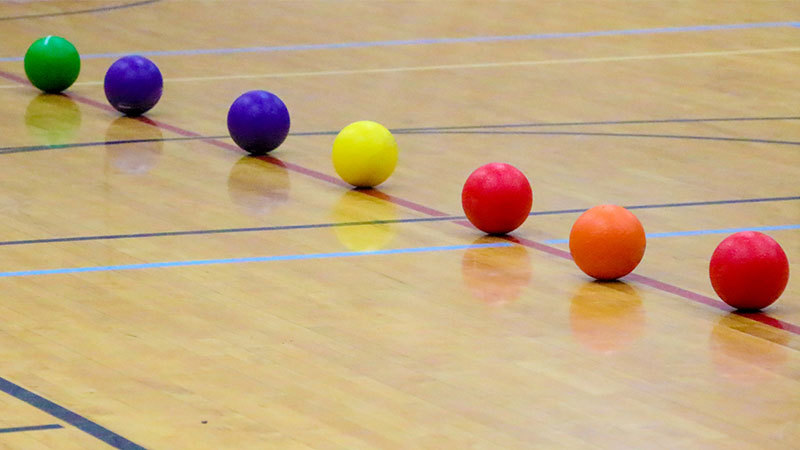In fourth grade, I was the shortest, quietest kid in class. I stumbled over my words most of the time, and needless to say, I wasn’t the shining star of gym class either.
I wasn’t exactly thrilled when it came time to play dodgeball, but my teacher, Coach Butler, had a special twist: He was going to use a P.E. game to teach us about the Revolutionary War. And what’s more, he insisted that I play George Washington.
To this day, I still remember Coach Butler’s vote of confidence, and because of his creative idea, I have a fond memory of gym class and some important historical facts, to boot. In this article, we’ll show you how you too can use dodgeball and other P.E. games to give your students a history lesson they’ll never forget.
How to Teach History With Dodgeball and Alternatives
Although this article focuses primarily on history, teachers of any subject can use this basic framework to help students memorize important facts. No matter what material you use, the rules of the game are the same: You will divide students into two teams, and neither team is allowed to leave their half of the gym while they play. Each team’s goal is to hit every member of the other team with a rubber or foam ball and get the other team “out” first.
However, this version of dodgeball has one twist: When a student is hit with a ball, he or she is not “out” automatically. Instead, students will have an opportunity to recite a fact about a specific topic you’ve assigned beforehand; if they get it right, they get to keep playing. We recommend assigning each student a different historical figure depending on what time period you’re discussing. For example, if you’re learning about the Cold War, one student might have Ronald Reagan, another Mikhail Gorbachev, and so on. Give students time before the game to research and learn facts about their assigned figure, and other students will benefit from hearing about different people as they play the game.
Alternatives to Dodgeball
Some schools and K–12 organizations have discouraged teachers from using dodgeball due to its potentially negative physical and emotional impact on students. Here are some alternative games you could play with this history activity:
- Gaga Ball: In Gaga Ball, players never pick up, throw, or kick balls. Instead, the balls roll or bounce around the gym floor, and students hit them with an open hand to try to tap another player below the knees to get him or her “out.” Foam balls are recommended. Similar to regular dodgeball, if students get hit below the knees, they can recite a historical fact to stay in the game.
- Star Wars Dodgeball: In this version of dodgeball, you use a large exercise ball to represent the Death Star and scatter cones throughout the gym as “space debris.” Each team throws their dodgeballs at the Death Star to try to cross it over the other team’s goal line. No one is allowed to touch the Death Star directly, or the game starts over and the other team gets a point. To incorporate the history activity, you can have students recite a fact every time the Death Star hits a cone.
- Capture the Flag: You could play a standard game of capture the flag either outside or in your school’s gym. If students are caught while crossing into the other team’s territory, they recite a fact about their historical figure to get out of “jail.”
Teaching the Revolutionary War With Gym Games
Below is a list of prominent figures from the Revolutionary War era, along with some examples of biographical facts students might learn about each. Before your dodgeball game, have students pick names out of a hat so they know who to research.
- Samuel Adams: A leading speaker and coordinator in the American resistance to British economic tyranny. Was a member of the Continental Congress. Became governor of Massachusetts after the war.
- Benedict Arnold: Defected from the Continental Army to the British to earn money to pay his debts. Planned to betray West Point to give control to the British, but his plan was discovered and he fled. Died in London in 1801, still in debt.
- Lord Charles Cornwallis: British general during the American Revolution. Defeated in 1781 by George Washington. His surrender at Yorktown marked the end of the American Revolution. Served Britain in India and Ireland after the war.
- King George III: King of Great Britain from 1760 to 1810, which included the French and Indian War, the Revolutionary War, and the Napoleonic Wars. Suffered from a mental illness later in life.
- Thomas Graves: British naval officer during the American Revolution. Notable battles include the Battle of the Chesapeake, the Battle of Saint Kitts, and the Battle of the Saintes.
- Alexander Hamilton: First Secretary of the Treasury. Chief of staff to George Washington during the Revolution. Founder of the Federalist Party. Created the first national bank. Shot and killed during a dual with Aaron Burr in 1804.
- John Jay: Governor of New York and first Chief Justice of the Supreme Court. Played a major role in helping get the Constitution ratified by the states. Wrote The Federalist Papers with James Madison and Alexander Hamilton. Responsible for the abolition of slavery in New York.
- Marquis de Lafayette: A French military officer who fought beside George Washington during the American Revolution. Played a role in the French Revolution as well but failed to keep the movement from becoming radical. Spent five years in prison during the French Revolution and was freed by Napoleon.
- Charles O’Hara: British military officer during the Seven Years’ War, the American Revolution, and the French Revolutionary War. Attended the surrender ceremony at Yorktown in General Cornwallis’s place when Cornwallis claimed he was ill.
- George Washington: Commander in Chief of the Continental Army and First President of the United States. Established the inaugural address, president’s cabinet, and tradition of serving only two terms as president.
- Anthony Wayne: American officer during the Revolutionary War. Noted campaigns include the Invasion of Quebec, the Philadelphia campaign, and the Yorktown campaign. Nicknamed Mad Anthony thanks to his military prowess and fiery personality. Continued to serve in the military after the Revolution until his death in 1796.
Teaching the Civil War in P.E.
Here are some major figures from the Civil War whom you can assign to your students. Again, if they can recite a fact about their assigned person after getting hit with the dodgeball, they can stay in the game.
- Braxton Bragg: An officer for the Confederate Army during the Civil War. Despite often having more soldiers under his command than the opposition, he lost most of the battles he headed.
- Sarah Edmonds: Canadian-born woman who disguised herself as a man to escape having to marry at age 15. Continued to live and sell Bibles as a man (for protection while she traveled alone). Enlisted in the Union Army and served under the name Franklin Thompson.
- Ulysses S. Grant: General of the Union Army during the Civil War who led the defeat of the Confederacy. Later became 18th President of the United States and oversaw Reconstruction efforts.
- Lewis Harris: Freed slave who joined the Union Army and fought in major campaigns such as the Sieges of Petersburg and Richmond. Continued to serve in the military for nearly three decades after the war.
- Hans Heg: An antislavery activist and politician in Wisconsin leading up to the Civil War. Led an all-Scandinavian immigrant regiment in the Union Army during the Civil War. Was killed in battle in 1863.
- Robert E. Lee: General in the Confederate Army during the Civil War. Was widely considered one of the finest generals in the country and was offered command of the Union Army (but declined). Strongly supported the reconciliation between the North and South after the war. Became president of Washington and Lee University after the war.
- Abraham Lincoln: 16th President of the United States, who served during the Civil War. Oversaw the defeat of the Confederacy and the abolition of slavery. Was assassinated in 1865 (the first U.S. president to die in this manner).
- James Longstreet: A general in the Confederate Army during the Civil War. Worked closely with Robert E. Lee, who nicknamed him “Old War Horse.” Particularly known for his failures that contributed to the Confederacy’s loss at the Battle of Gettysburg.
- Hannah Reynolds: Slave who refused to leave the Appomattox Court House after her masters fled in the face of oncoming soldiers. Only known civilian casualty of this battle, which led to Robert E. Lee’s surrender. Killed by a Confederate artillery shell that struck her while she lay in bed as the battle raged.
- Edwin M. Stanton: Secretary of War under the Lincoln Administration during the American Civil War. After Lincoln’s assassination, President Johnson tried to dismiss Stanton, a conflict that ultimately led to the president’s impeachment (the first presidential impeachment in American history).
- Fernando Wood: Mayor of New York City and member of the House of Representatives from New York. Although from a Northern state, he supported the Confederacy and wanted New York City to secede from the Union, likely because the city profited considerably from the cotton trade. After the war, he opposed the 13th Amendment.
Teaching Women’s Suffrage in Gym Class
Election time or Women’s History Month might be a good time to introduce some of these key figures from the women’s suffrage movement.
- Susan B. Anthony: Daughter of a Quaker abolitionist. Became a teacher at 17 years old and advocated for coeducation and college education for women. Organized the first women’s temperance association, the Daughters of Temperance. Founded the National Woman Suffrage Association with Elizabeth Cady Stanton in 1869. Arrested in 1872 for trying to vote in New York.
- Alice Stone Blackwell: Daughter of women’s rights movement leaders Henry Browne Blackwell and Lucy Stone. Niece of Elizabeth Blackwell, America’s first female physician. Graduated from Boston University in 1881; was also president of her class. Editor of the Woman’s Journal from 1881 to 1917. Translated several works of poetry from around the world into English.
- Carrie Chapman Catt: Graduated from Iowa State College in 1880. Superintendent of schools in Mason City, Iowa. Became president of the National American Woman Suffrage Association in 1900. Organized the League of Women Voters to educate women in politics and public affairs after the passage of the 19th Amendment. Became a peace advocate after the women’s rights movement.
- Paulina Wright Davis: Was orphaned at a young age. Wanted to be a missionary, but the church wouldn’t allow single women to become missionaries. Was involved in the abolitionist movement. Studied and taught medicine to women. In 1853, founded Una, the first women’s rights paper in the U.S. Published A History of the National Women’s Rights Movement in 1871.
- Julia Ward Howe: Wrote “The Battle Hymn of the Republic” in 1861. Became the editor of the Woman’s Journal (a suffragist magazine) in 1872. Was the first female member of the American Academy of Arts and Letters. Wrote Modern Society (1881), a biography of Margaret Fuller, and several volumes of poetry.
- Belva Ann Lockwood: Worked as a teacher in her early adult life. Attended the National University Law School from 1871 to 1873 and became a lawyer. Was the first woman to practice law before the U.S. Supreme Court in 1879. Ran for president twice (1884 and 1888) for the National Equal Rights Party. Wrote the congressional amendments granting suffrage to women in Oklahoma, Arizona, and New Mexico.
- Anna Howard Shaw: Born in England in 1847 and emigrated to the U.S. in 1851. Earned degrees in theology (1878) and medicine (1885) from Boston University. Was ordained by the Methodist Protestant denomination in 1880. Met Susan B. Anthony in 1888 and joined the women’s suffrage movement. Was the president of the National American Woman Suffrage Association from 1904 to 1915.
- Elizabeth Cady Stanton: Married Henry Stanton and joined him in his abolitionist work, including attending an international convention in London where women were excluded from the proceedings. Helped organize the first women’s rights convention in 1848 in Seneca Falls, New York. Presented the Declaration of Sentiments at the convention. Did not support the wording of the 14th and 15th Amendments because they did not grant voting rights to women. Ran for Congress in New York before women were allowed to vote (and won 24 votes).
- Lucy Stone: The first woman in Massachusetts to earn a college degree. Worked as a lecturer for the Anti-Slavery Society. Kept her maiden name after marriage (which was unheard of at the time). Cofounded the American Woman Suffrage Association after a fallout with Susan B. Anthony and Elizabeth Cady Stanton over the 14th and 15th Amendments. Founded the Woman’s Journal in 1870.
- Mary Church Terrell: Daughter of ex-slaves. Earned her bachelor’s degree in 1884 and master’s degree in 1888. Founded the Colored Women’s League in 1892. First president of the National Federation of Colored Women. First black woman appointed to the District of Columbia Board of Education. Was a charter member of the NAACP. Received honorary doctorates from Howard University, Wilberforce College, and Oberlin College.
- Sojourner Truth: Was born Isabella Baumfree but later changed her name to Sojourner Truth. Was born a slave, but an abolitionist couple bought her freedom when she ran away from her former master with her infant daughter. Became a traveling preacher and political activist who fought for abolitionism and women’s rights. Received an invitation to meet Abraham Lincoln in the White House in 1864.
- Frances Elizabeth Willard: Graduated from Northwestern Female College in 1859. Became president of Evanston College for Ladies in 1871. Was a prolific writer and speaker for temperance and women’s rights causes; averaged 400 lectures a year for a decade. Became president of the Woman’s Christian Temperance Union in 1879.






